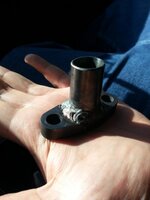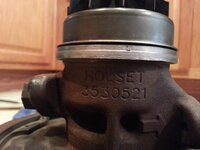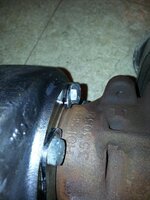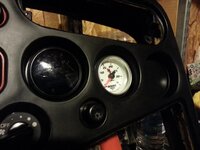Ludejim
10+ Year Contributor
- 63
- 10
- Apr 28, 2010
-
Centennial,
Colorado
This is my first attempt at anything of this magnitude. I have done smaller projects on cars and motorcycles, but until now, I had never pulled a motor or done anything that I am about to show you. Also note that the order in which I present these modifications does not represent the actual order in which they were completed, although I did try and present them in a manageable order.
Contents:
At anytime, you can press control + F in the browser window and search for each of these terms. It will take you to the beginning of that part of the project.
Motor Failure
I got my 1993 1G TSi 7-bolt about a year and a half ago, it ran great and I loved it. I got ECMLink V3, a wideband O2, and changed the intake on the car to speed density. This being my first turbo car I really neglected the oil. With a few oil leaks around the oil pan, the turbo oil feed leaking, and numerous other things that I had no idea about, it does not surprise me that the engine failed due to lack of oil. It was definitely my fault, I have come to terms with that and I am ready to rebuild my car and take care of it properly. Sorry if there are pictures missing here or there. Here are some pictures of the engine pull:

Valve cover, exhaust manifold, turbo, throttle body, and most of the electrical/vacuum/coolant lines removed.

Engine out!
Head removed. Camshafts, valves, springs, retainers, and seals are all gone. At this point you can also see the crank in the background along with the girdle. No damage was done to the head which makes me happy ?
This, on the other hand, does not make me very happy. Nearly every bearing was shot.

The thrust bearing is really bad.

Crank discoloration.

This is where the crank was walking into the block.
At this point I knew what had happened, and I just needed someone who could help me out. I do not build engines and I do not have the correct tools nor the knowledge. I jumped on my motorcycle and took a trip down to Jacks Transmissions in Colorado Springs. Turns out I chose the wrong day.

About 15 minutes away from Jacks, I got hit by a huge thunderstorm. I pulled over into the gas station and waited it out. Took about 30 minutes and then I was back on the road to Jacks. I talked to Jack for probably an hour and a half. Picking his brain on what could be done to my motor. We decided that using my block and crank was a bad idea because the crank had heat stress and discoloration and the block had wear marks from the crank walking. Jack set out to build me a 6-bolt block with 2G pistons, 1G rods, and the thrust bearing out of the later model 4G63s. There is nothing super special about the bottom end, except for the fact that it is new. From here it was a waiting game, and I knew it was going to be a while before I got my engine back.
Throttle Body
I apologize that I do not have before pictures, but rest assured, the throttle body was nasty.
Here is a list of things done to the throttle body
1. New ISC Motor
2. New O-ring seals
3. Vacuum lines looped
4. FIAV Bypass plate (Not in picture)
5. Plugged FIAV coolant lines (not in picture)
6. Polished throttle plate and cleaned surfaces


Motor Mounts
I had the front and rear motor mounts welded up with 3/16 steel plates.

The left and right side were treated to new Prothane motor mount inserts. I do not have separate pictures of these. I did have to pay to get the old inserts pressed out. You can see the new Prothane mounts later down in pictures of the motor install.
Turbo, exhaust manifold, intake manifold
I got a call from Jacks Transmission telling me that my motor was finished. So I drove down to Colorado Springs to pick it up. I took my head, valves, cams, springs, lifters, and retainers down to Jack so that he could put them on the new block.


I placed an order for an FP exhaust manifold.

A new BEP housing.

And an hx-35 CHRA and compressor housing.

The turbo, BEP housing, FP manifold, and stock intake manifold bolted up. The intake manifold was cleaned at Heads by Drew. Also you can see my oil feed line for my turbo coming from the 1990 OFH.

My oil return line consists of a stock holset return line flange with about 1 of 19mm I.D. tubing connected to a ¾ I.D. silicone hose that connects to a stock 2g oil return line that has been cut down just a little.

I changed my turbo water pipe to the none turbo pipe because the hx-35 is oil cooled only. My compressor cover just barely touched my water pipe.

Contents:
At anytime, you can press control + F in the browser window and search for each of these terms. It will take you to the beginning of that part of the project.
- Motor Failure
- Throttle Body
- Motor Mounts
- Turbo, exhaust manifold, intake manifold
- Putting the motor in
- Clutch & Transmission
- Parts Delivery
- External Oil Cooler
- Battery Relocation
- VRSF FMIC Install
- WasteGate
- MAP Sensor, AFPR, and Partial wire tuck
- PCV valve and oil pressure sending units
- Looping lines
- Cold Air Intake
- Gauges
- Fuel Pump Rewire
Motor Failure
I got my 1993 1G TSi 7-bolt about a year and a half ago, it ran great and I loved it. I got ECMLink V3, a wideband O2, and changed the intake on the car to speed density. This being my first turbo car I really neglected the oil. With a few oil leaks around the oil pan, the turbo oil feed leaking, and numerous other things that I had no idea about, it does not surprise me that the engine failed due to lack of oil. It was definitely my fault, I have come to terms with that and I am ready to rebuild my car and take care of it properly. Sorry if there are pictures missing here or there. Here are some pictures of the engine pull:
Valve cover, exhaust manifold, turbo, throttle body, and most of the electrical/vacuum/coolant lines removed.
Engine out!
Head removed. Camshafts, valves, springs, retainers, and seals are all gone. At this point you can also see the crank in the background along with the girdle. No damage was done to the head which makes me happy ?
This, on the other hand, does not make me very happy. Nearly every bearing was shot.
The thrust bearing is really bad.
Crank discoloration.
This is where the crank was walking into the block.
At this point I knew what had happened, and I just needed someone who could help me out. I do not build engines and I do not have the correct tools nor the knowledge. I jumped on my motorcycle and took a trip down to Jacks Transmissions in Colorado Springs. Turns out I chose the wrong day.
About 15 minutes away from Jacks, I got hit by a huge thunderstorm. I pulled over into the gas station and waited it out. Took about 30 minutes and then I was back on the road to Jacks. I talked to Jack for probably an hour and a half. Picking his brain on what could be done to my motor. We decided that using my block and crank was a bad idea because the crank had heat stress and discoloration and the block had wear marks from the crank walking. Jack set out to build me a 6-bolt block with 2G pistons, 1G rods, and the thrust bearing out of the later model 4G63s. There is nothing super special about the bottom end, except for the fact that it is new. From here it was a waiting game, and I knew it was going to be a while before I got my engine back.
Throttle Body
I apologize that I do not have before pictures, but rest assured, the throttle body was nasty.
Here is a list of things done to the throttle body
1. New ISC Motor
2. New O-ring seals
3. Vacuum lines looped
4. FIAV Bypass plate (Not in picture)
5. Plugged FIAV coolant lines (not in picture)
6. Polished throttle plate and cleaned surfaces
Motor Mounts
I had the front and rear motor mounts welded up with 3/16 steel plates.
The left and right side were treated to new Prothane motor mount inserts. I do not have separate pictures of these. I did have to pay to get the old inserts pressed out. You can see the new Prothane mounts later down in pictures of the motor install.
Turbo, exhaust manifold, intake manifold
I got a call from Jacks Transmission telling me that my motor was finished. So I drove down to Colorado Springs to pick it up. I took my head, valves, cams, springs, lifters, and retainers down to Jack so that he could put them on the new block.
I placed an order for an FP exhaust manifold.
A new BEP housing.
And an hx-35 CHRA and compressor housing.
The turbo, BEP housing, FP manifold, and stock intake manifold bolted up. The intake manifold was cleaned at Heads by Drew. Also you can see my oil feed line for my turbo coming from the 1990 OFH.
My oil return line consists of a stock holset return line flange with about 1 of 19mm I.D. tubing connected to a ¾ I.D. silicone hose that connects to a stock 2g oil return line that has been cut down just a little.
I changed my turbo water pipe to the none turbo pipe because the hx-35 is oil cooled only. My compressor cover just barely touched my water pipe.
Last edited:



 that old crappy boost gauge is about to get upgraded. I eliminated the air source selection knob. I still need to paint it, looks like crap but functions and because race car.
that old crappy boost gauge is about to get upgraded. I eliminated the air source selection knob. I still need to paint it, looks like crap but functions and because race car.





 , and after moving it to the throttle body elbow I confirmed to myself that the IM was heat soaking the sensor. Now my IATs are at a respectable 80-90 degrees.
, and after moving it to the throttle body elbow I confirmed to myself that the IM was heat soaking the sensor. Now my IATs are at a respectable 80-90 degrees. 













